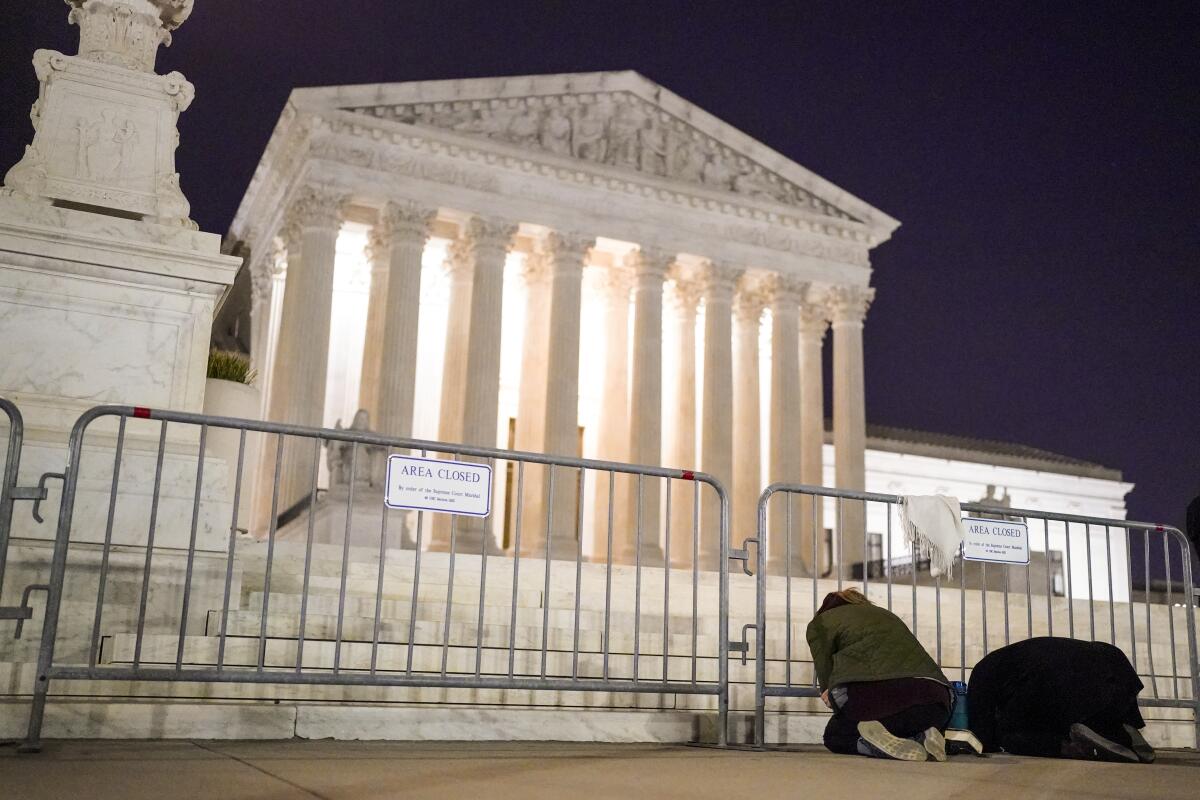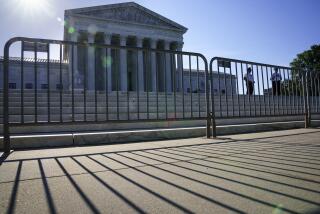News Analysis: Supreme Court likes separation of powers, but not of church and state

WASHINGTON — The Constitution is famously built on checks and balances, but nowhere does it specifically call for a “separation of powers” or insist on a “separation of church and state.”
Those two widely understood legal concepts evolved over more than two centuries of rulings.
Today, however, the emboldened Supreme Court conservative majority is relying on one — separation of powers — to block progressive policies and regulations, even as it chips away at the other — the line between government and religion.
While the recently concluded court term will be best remembered for its rulings on abortion and guns, it also saw the emergence of a new antiregulatory activism.
The justices stopped a Biden administration regulation to extend a moratorium on evictions during the COVID-19 pandemic and tossed out a rule that would have required large employers to vaccinate their workers.
Then on the final day of the term, the justices blocked the Environmental Protection Agency from adopting broad regulations to combat climate change. They rejected an Obama-era rule that could have forced a shift away from coal-fired power plants in favor of natural gas, solar power and wind turbines.
While environmentalists and the court’s three liberals focused on the threat of a global climate catastrophe, the conservatives saw the issue as one of separation of powers.
Chief Justice John G. Roberts Jr. said the government’s response to climate change is a “major question” that must be decided by Congress, not by agency regulators or the president. In essence, the court ruled the regulation was tantamount to new legislation.
“The major questions doctrine ... protects the Constitution’s separation of powers,” Justice Neil M. Gorsuch wrote in a concurring opinion that explains the conservative view. “In Article I, the People vested all federal legislative powers in Congress.” They did not “create a regime administered by a ruling class of largely unaccountable ‘ministers.’ Under our Constitution, the people’s elected representatives in Congress are the decisionmakers here.”
Gorsuch pointed to the “explosive growth of the administrative state since 1970,” and the theory he outlined does not leave much room for significant regulation.
UCLA law professor Jon Michaels described it as “justifying a radical effort to reverse 90 years of court-approved broad-reaching federal delegations.”
It was fitting the ruling came on the day Justice Stephen G. Breyer officially retired.
Throughout his 28 years, Breyer was the court’s foremost champion of federal agencies. As he saw it, Congress passed broad laws to clean the air and protect workers, consumers and investors, but left it to the federal agencies to make those promises effective.
When cases came before the court, he spoke of agency officials as serious-minded experts who were trying to make government work.
But on the right, the “administrative state” has been under attack for decades, and regulations are routinely derided as “power grabs” by unelected left-leaning bureaucrats.
The libertarian CATO Institute hailed the EPA ruling as “a great day of liberty,” while the progressive American Prospect said the Supreme Court has “staged a coup against government regulation ... and endangered the planet in the process.”
The split on the high court matches the political divide in Washington. Democratic administrations have relied on regulations to enforce environmental protection and civil rights, while Republicans have chafed at rules that are opposed by employers and corporations.
The conservative majority is far less enthusiastic about another kind of “separation,” between church and state.
In a letter written in 1802, President Thomas Jefferson described the 1st Amendment as erecting a “wall of separation between church and state.” It protects both the free exercise of religion and against an “establishment of religion.”
The Supreme Court adopted the founding father’s metaphor in a unanimous 1947 opinion by Justice Hugo Black. The 1st Amendment’s ban on an “establishment of religion” means the government may not “aid one religion, aid all religions, or prefer one religion over another,” he wrote in Everson vs. Board of Education. “No tax in any amount, large or small, can be levied to support any religious activities or institutions ... to teach or practice religion.”
In 1962, Black wrote the court’s opinion striking down the reading of official prayers in the public schools, a ruling that won the endorsement of President John F. Kennedy, the nation’s first Catholic to hold the office.
By contrast, the court’s conservatives led by Justice Clarence Thomas now deride church-state separation and the ban on funding religious schools as a 19th century doctrine “born of bigotry” against Catholic immigrants.
“It was an open secret that ‘sectarian’ was code for ‘Catholic’ [and] arose at a time of pervasive hostility to the Catholic Church and to Catholics in general,” Chief Justice John G. Roberts Jr. wrote in a 2020 decision that struck down Montana’s ban on public funds for religious schools. (Espinoza vs. Montana)
Last month, in a pair of 6-3 rulings, the court struck down Maine’s ban on state tuition aid for students enrolled in religious schools (Carson vs. Makin), and it ruled for a high school football coach who, in defiance of school officials, knelt in prayer on the 50-yard line after games. (Kennedy vs. Bremerton)
The court’s majority said the 1st Amendment protected the coach’s right to free speech and the free exercise of religion.
In dissent, Justice Sonia Sotomayor said the ruling “elevates one individual’s interest in personal religious exercise ... over society’s interest in protecting the separation between church and state.”
The next target for reversal may be the 1970s-era rulings that said cities and school districts may not openly display religious symbols on public property, including crosses, the Ten Commandments or nativity scenes at Christmas.
Gorsuch wrote another broad explanatory opinion in May arguing the ban on “establishment of religion” was mostly limited to laws that would require people to support a church or participate in a religious activity. He said it did not forbid a government action because it appears to “endorse” or favor religion.
He argued that the court went too far in the 1970s by adopting this no-endorsement approach.
Until then, “this court had never held the display of a religious symbol to constitute an establishment of religion,” he wrote in Shurlett vs. Boston. “Our Constitution was not designed to erase religion from American life; it was designed to ensure respect and tolerance.”
Defenders of church-state separation worry where the court is headed. They say it would be a mistake to inject religion into public schools, city halls or county boards.
“Our concern is that this reordering of constitutional values harms religion and will cause more conflict,” said Holly Hollman, counsel for the Baptist Joint Committee for Religious Liberty. “The effects on religious minorities will be felt most acutely. But the more the government is allowed to promote religion, the more it will distort religion. Christians should be concerned that religion will become just another tool in a politically divided nation.”
More to Read
Get the L.A. Times Politics newsletter
Deeply reported insights into legislation, politics and policy from Sacramento, Washington and beyond. In your inbox three times per week.
You may occasionally receive promotional content from the Los Angeles Times.











